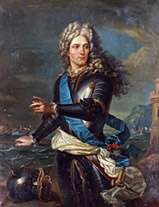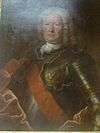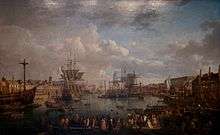Flotte du Ponant
| Flotte du Ponant | |
|---|---|
|
The arsenal of Brest in 1776 Tableau of Louis-Nicolas Van Blarenberghe (1716 - 1794) | |
| Active | 1669 – 1792 |
| Country |
|
| Branch |
(French: Marine royale française) |
| Type | Naval fleet |
| Role | Naval operations in Manche, the Atlantic Ocean and American Oceanic Waters |
| Garrison/HQ | Arsenal of Brest, Le Havre, Rochefort, Lorient, Cherbourg and Brouage |
| Engagements |
Franco-Dutch War Nine Years' War War of the Spanish Succession War of the Austrian Succession Seven Years' War Independence War of the United States (U.S.) |

The term Flotte du Ponant designated under the Ancien Regime the ensemble of naval vessels of the Royal French Navy (French: Marine royale française) destined for naval operations ( naval supremacy, protection of convoys) in Manche (French: La Manche), the Atlantic Ocean and American Oceanic Waters ( principally in the French West Indies and New France). The fleet is the alter ego of the Levant Fleet, based in the Mediterranean Sea.
Arsenals
The Flotte du Ponant was created by Cardinal Richelieu. The fleet consisted of three principal bases: Le Havre, Arsenal of Brest and Hiers-Brouage.
Under Louis XIV, the arsenal of Brest was the principal confirmed arsenal, supported by the arsenals of Rochefort and Lorient.
Under Louis XVI, the military port of Cherbourg is added, which structures were recently being commissioned when the French Revolution debuted.
Admirals Vessels
The admiral vessel (French: navire amiral) was always the most powerful unit present at Brest, being:
- The Soleil Royal (French: Soleil Royal), launched in 1669, admiral vessel at the Battle of cap Béveziers (French: Bataille du cap Béveziers), saute in 1692 following the Battles of Barfleur and La Hogue (French: Barfleur);
- The Soleil Royal (French: Soleil Royal), launched in 1692, sabordage (scuttled) at the Battle of Toulon (1707) (French: Siège de Toulon en 1707), demolished in 1714;
- The Foudroyant, launched in 1724, demolished in 1743;
- The Soleil Royal (French: Soleil Royal), launched in 1749, burned after the Battle of Quiberon Bay (French: Cardinaux) in 1759;
- The Royal Louis, launched in 1759, demolished in 1727;
- The Bretagne (French: Bretagne), launched in 1776, admiral vessel, Battle of Ushant (1778) (French: Ouessant), renamed the Révolutionnaire, demolished in 1796;
- The États de Bourgogne , launched in 1790 as Montagne, then Peuple, then Océan, admiral vessel during the naval battles of Glorious First of June (French: Prairial), the Battle of Groix (French: Groix), the Saint-Domingue expedition (French: Saint-Domingue) and the Battle of the Basque Roads (French: bataille de l'île d'Aix), then demolished in 1859.
Vice-admirals
- Aymar de Clermont-Chaste-Gessans (French: Aymar de Clermont-Chaste-Gessans) (died in 1603), Knight Order of Ordre de Saint-Jean de Jérusalem (French: Chevalier de l'ordre de Saint-Jean de Jerusalem), Grand-Maître of the Ordre de Saint-Lazare (French: Ordre de Saint-Lazare) (1593), Vice-admiral of Les Mers du Ponant.
The commandment of the two fleets ( Ponant and Levant) was entrusted on November 12, 1669 to two Vice-admirals. The vice-admirals of the Ponant were :
| Name | Portrait | Tenure | Note |
| Jean II d'Estrées (French: Jean, comte d'Estrées) Count d'Estrées (1624-1707) |  | 1669–1707 | Tenure at age 45 until his death in 1707 |
| Victor-Marie d'Estrées (French: Victor Marie d'Estrées) (son of Jean II d'Estrées) (1660-1737) |  | 1707-1737 | Heraldry Tenure at age 46 until 1737 |
| Antoine François de Pardaillan de Gondrin (French: Antoine François de Pardaillan de Gondrin) Marquis d' Antin (1709-1741) | - | (1737-1741) | .svg.png) Tenure at age 28 until 1741 |
| François de Bricqueville (French: François de Bricqueville) Count de La Luzerne (1665-1746) | - | (1741-1746) | Tenure at age 79 until 1746 |
| Claude-Élisée de Court de La Bruyère (French: Claude-Élisée de Court de La Bruyère) (1666-1752) |  | 1750-1752 | Commandement of admiral-vessel Le Terrible (1739) in 1744 (French: Le Terrible (1739)) bearing the mark of naval forces Lieutenant-General Court de La Bruyère Vice-Admiral tenure at age 84 in 1750 until 1752 |
| François-Cornil Bart (French: François-Cornil Bart) (son of Jean Bart) (1677-1755) |  | 1752-1755 |  Tenure at age 75 |
| Charles-Félix de Poilvilain (French: Charles-Félix de Poilvilain) Count de Cresnay (1693-1756) | - | 1755-1756 | Tenure at the age of 62 until 1756 |
| Jean-Baptiste Mac Nemara (French: Jean-Baptiste Mac Nemara) Irish descendent (1687-1756) | - | 1756-1756 | Tenure at age 66 and died the second day after his nomination |
| Hubert de Brienne (French: Hubert de Conflans, comte de Brienne) Count de Brienne (1690-1777) | - | 1756-1777 | .svg.png) Tenure at age 66 until 1777 |
| Joseph de Bauffremont (French: Joseph de Bauffremont, prince de Listenois) (1714-1781) |  | 1777-1781 |  Tenure at age 63 until 1781 |
| Paul-Hippolyte de Beauvilliers (French: Paul-Hippolyte de Beauvilliers) Marquis de La Ferté-Saint-Aignan (1712-1788) | - | 1781-1788 | .svg.png) Tenure at age 69 until 1788 |
| Pierre-Antoine de Raymond, bailli d'Éoux | - | 1788-1792 | Tenure at age 82 until 1792 |
In case d'Estrées commanded the fleet during the battles of the reign of Louis XIV, his successors would have hardly served at sea with such a senior age. The squadrons were confined during the 18th century to the Lieutenant Generals of the Naval Armies (French: lieutenants généraux des armées navales).
The rank lieutenant-general of the armies (French: Lieutenant-général des armées) or Lieutenant-general of the naval armies (French: lieutenant-général des armées navales) for la Marine, was the highest rank in the military hierarchy of the Ancien Regime, only accessible to nobility. He was only surpassed by the Marshals of France, the colonel generals (French: Colonel general), for the Army, the Admirals of France and vice-admirals of France, for la Marine, titled not of a military rank but of a grand office of the French crown (French: grand office de la couronne de France), a dignity both honorific and lucrative. The rank of lieutenant general was the equivalent of the actual rank of division general and that of lieutenant-general of naval armies of the Vice-admiral of France.
The ranks of lieutenant-general of the armies were renamed as division general and vice-admiral in 1791. In 1814, the rank of division general was designated again as lieutenant general of the armies, before definitely being attributed the rank of general in 1848.
Administration of La Marine (the Navy)

The navy (La Marine) (French: Administration de la Marine royale française) appeared in the attributions of the Secretary of the State in 1626, the same year where Cardinal Richelieu was designated as grand master of navigation. The two fleets were united in 1642, then dissociated in 1661. The two naval fleets were attributed to Colbert since 1662, while the intendant of finance and state minister, then secretary of State in 1669. There was then a secretary of state in charge of the navy until the French Revolution.
The state secretary of the navy (French: secrétaire d'État à la Marine) was the administrative responsible for the French naval military ( the French royal naval fleet ) and the civilian naval component ( commercial trade fleet ). Accordingly, the secretary housed in his department, both naval war fleets and commercial fleets, the arsenals (French: arsenaux), the consulats (French: consulats), the colonies (French: colonies) and the French East India Company (French: compagnies de commerce).
At the base origin of the two bureaux, bureau of Ponant and bureau of Levant, other services were also progressively added:
- archives depots, 1669;
- consulat bureau of Ponant, 1709;
- colonies bureau, 1710;
- class bureau, 1711;
- depot for maps and plans, 1720;
- consulat bureau of the Levant, 1738, which merged in 1743 with consulat bureau of Ponant under the designation of commerce and consulats bureau.
These different bureaux and depots were regrouped in four grand directorates by marshal Charles Eugène Gabriel de La Croix (French: de Castries) in 1786.
During the French Revolution, the flotte du Ponant was re-baptized « Escadre de l'Atlantique» ( Atlantic Squadron ) then « Flotte de l'Océan » (Ocean Fleet).
See also
- Luc-Julien-Joseph Casabianca
- List of ships of the line of France
- Levant Fleet
- Troupes de la marine
- List of submarines of France
-Louis-Nicolas_Van_Blarenberghe_mg_8233.jpg)